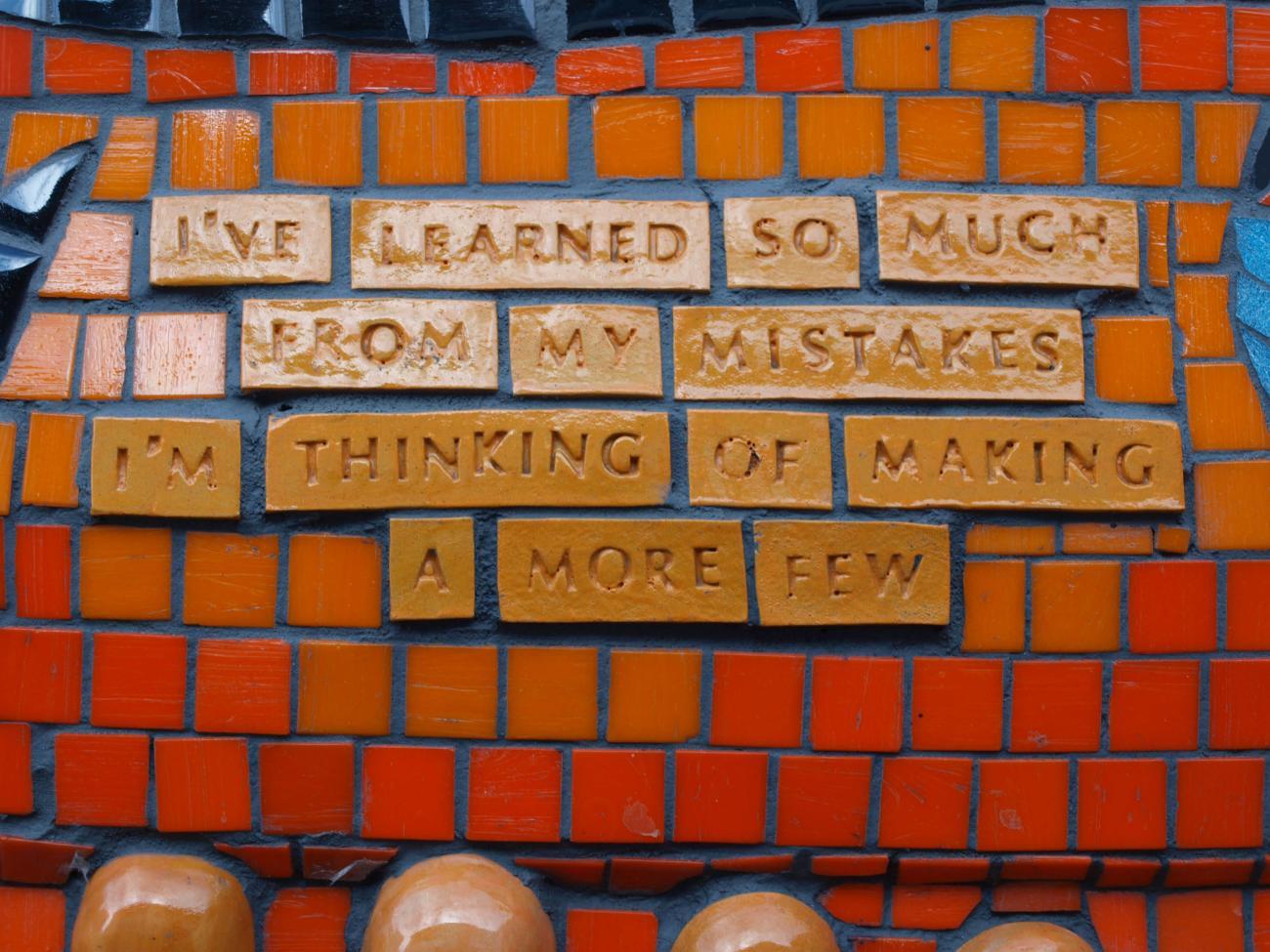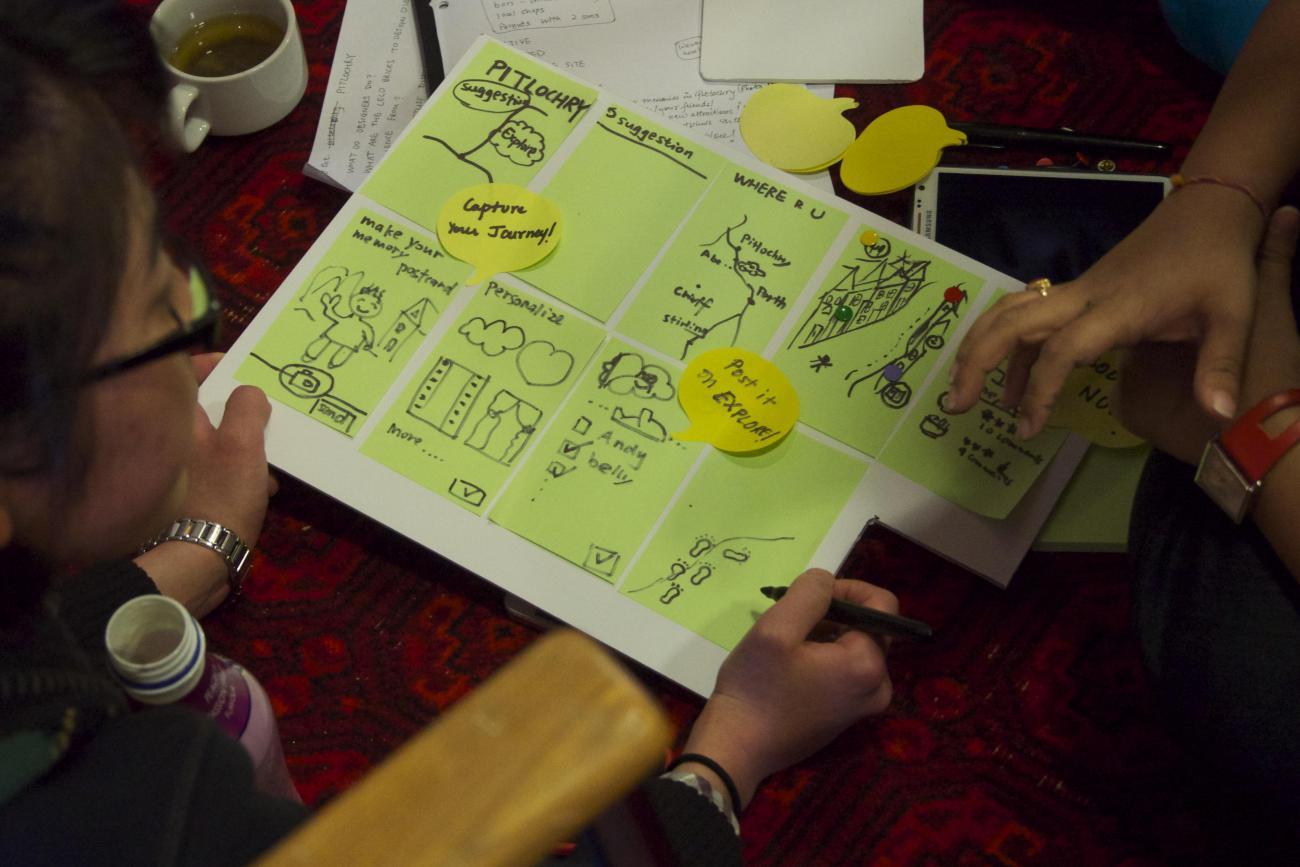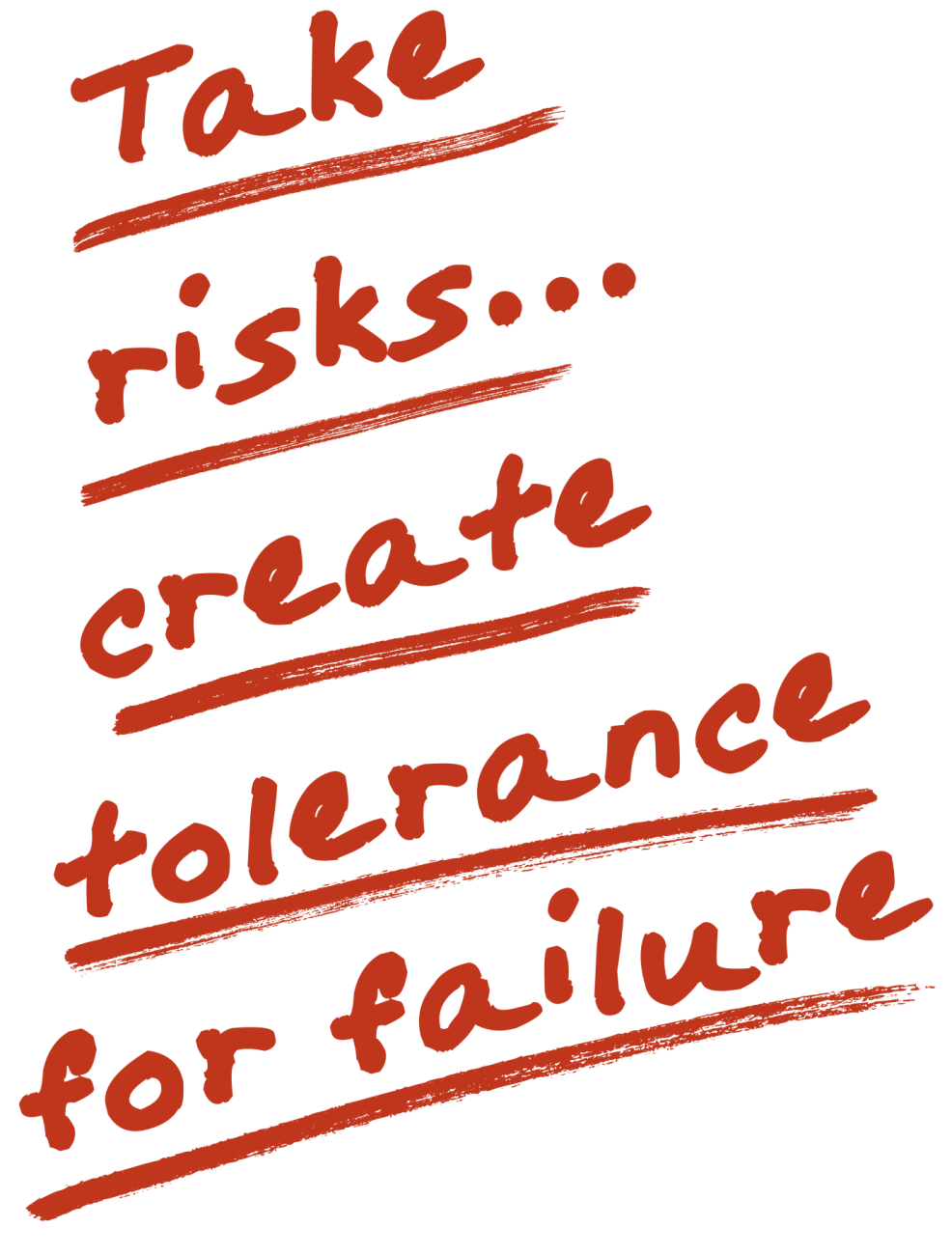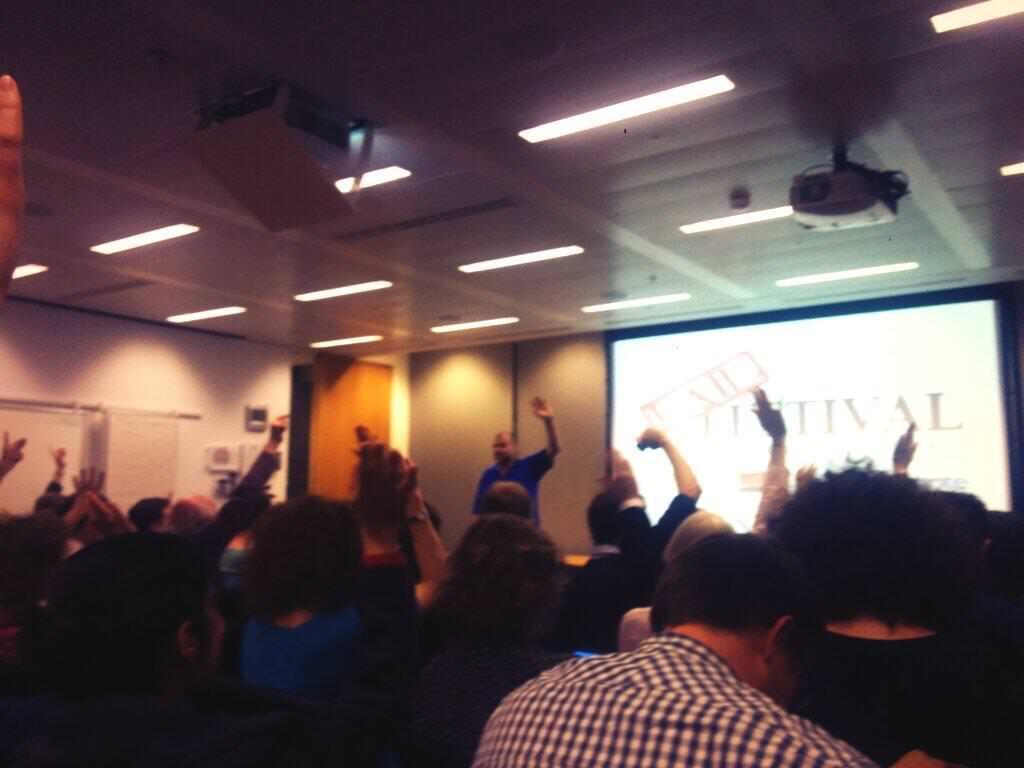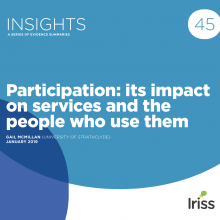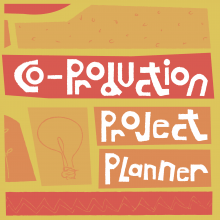Don’t we learn more from success than failure?
It's a terrible thing, I think, in life to wait until you're ready. I have this feeling now that actually no one is ever ready to do anything. There's almost no such thing as ready. There's only now. And you may as well do it now… I'm not a crazed risk taker. But I do think that, generally speaking, now is as good a time as any.
Hugh Laurie
Explanation
The premise of this Iriss On… is that it is important to be able to adapt, to be flexible and to share our experiences of failure and success so that others can learn from us. Our position is that if we conceptualise failure as intrinsic to learning and improvement, then admitting it to ourselves and to others shouldn't be so hard. Learning in this way is vital in social services (in particular) as we have a responsibility to know exactly what difference we are making all of the time.
Ok, so putting thoughts down on paper about failure, mitigating risk by testing early, prototyping and learning from mistakes isn't easy.
What you are reading now is a draft document that was written in a few hours, instead of a few days. It's just a test, to judge the level of interest in the topic. It's been reviewed by colleagues internally at Iriss (1) but releasing it in its current form is hard. The toughest part of putting out an early iteration of something is getting over the fact that what's produced might not be perfect (in fact, it is incredibly likely that it will be imperfect!) We will want to add more ideas, more thoughts, more features before releasing the simple early version. The tougher part still is that it is likely to be judged and criticised, and it might possibly fail.
So, here it is. Let's see if this still has elements of failure.
Introduction
We require an ability to remain nimble in this ever-changing, progressively complex and interconnected world that's faced with integration of services and supports. The complexity of the problems that we are trying to solve doesn't have simple linear answers. Instead, these problems require an element of trial and error, testing new things that may or may not work. This includes creating the capacity for acceptance of failure so that we can see innovation come to life.
Image credit: By Edmund S. Valtman [Public domain], via Wikimedia Commons
Try again. Fail again. Fail better.
Samuel Beckett
The principle that we learn from failure makes perfect sense. Understanding why something hasn't worked prevents us (hopefully) from making the same mistakes again and helps us to understand and move on. We also accept that risk and failure are central components of innovation, yet the fear of failure remains strongly embedded in our culture in social services.
Don't we learn more from success than failure?
There is a big push at the moment to 'fail early, fail fast, fail often' (eg Babineaux and Krumboltz, 2013). However, a hotly contested debate in the literature remains whether or not we learn more from failure than we do from success.
Some Harvard academics go as far as to suggest that…
Success can breed failure by hindering learning at both the individual and the organisational level.
Gino and Pisano, 2011
They believe that success tends not to inspire the kind of questions that difficulty does (the 'failure to ask syndrome'). This suggests that when we reflect on previous successful projects, we are over-confident about our own contribution to the outcome, giving ourselves more credit than the environmental or extraneous factors that could equally have contributed.
However, research into After Action Reviews (used in military situations where the stakes of failure can hardly be higher), suggests a way forward. Ellis and Davidi (2005) found that focusing on both successes and failures was critical for higher rates of learning. In particular, they found that soldiers discussing both successes and failures appeared to learn faster because they developed 'richer mental models' of their experiences than soldiers who only discussed failures.
Image credit: YIP Day 70 - More Few by Paula Bailey, on Flickr
So do we learn from failures and successes in social services?
Learning from success is common at a strategic level - with much current policy and practice being focused on learning from and about 'what works'. However, on a personal level, this type of learning is rarer because there is less of an imperative. There is no manager looking for answers; no tragedy to respond to; no people asking difficult questions. Learning from success requires a more strategic, proactive mindset. However, at times we can be a little too focused on failure - particularly when considering work with communities. We don't always pay attention to identifying the protective factors or other characteristics that lead to resilience and positive outcomes (ie success) for some.
Evidence from Walshe and Higgins (2002) suggests that although we are good at writing reports and commissioning inquiries about our failures in the sector (focus of the analysis was the NHS), we are not as good at acting on these recommendations. They found that in an analysis of major inquiries in the NHS from 1969-2001, there were a number of consistent themes which indicate that although lessons are being learned, these lessons are not being applied in practice. They suggested that…
"often these failures are organisational and cultural, and the necessary changes are not likely to happen simply because they are prescribed in a report"
(p895)
But people make mistakes, not organisations - Don't they?
Image credit: 'Catherine facepalm' by Eurritimia/Flickr
Well, sometimes people do make mistakes, but other times the system or organisation that hosts those people can be responsible. Human factors psychologist James Reason (2000) categorises the different organisational responses to dealing with failure as:
Active Failures - are unsafe acts undertaken by people. These may be (relative to latent failures) frequent, limited in cause and consequence and hard to foresee. This can be seen as a 'personal' approach where individuals are subsequently blamed for mistakes. This can lead to a blame culture which prevents us from understanding and addressing the underlying conditions that led to the mistake in the first place.
Latent Failures - are organisational and inherently reside within the system or organisation. When contrasted with active failures, they are usually rare, have multiple causes, have widespread impact and longer term consequences. This can be seen as a 'system' approach which sees errors and poor practice as a result of the conditions under which people work and how the system or organisation is structured. Latent failures can often be identified and remedied without an accident or failure occurring.
Unfortunately in the world at large, "success happens in private and failure in public view" (anon). There are significant implications for this, particularly in social services. Brown (2010) suggests that the wider context of audit and 'blame' in the public and social services (an 'active failure' approach) has led to situations where 'social workers can be publicly named, shamed and sacked when mistakes are made'. This means that the stakes can be particularly high when practitioners in our sector are trying to innovate.
"Accidents, like a fraying rope, are always a series of missed opportunities, but the blame typically falls on the final strand in a rope that breaks - often it is the human being."
Deborah Hersman, 2014
Indeed, a recent article Social work regulation: help or hindrance? in the Guardian highlighted research where social work practitioners talked about increasing 'cautious practice' and 'doing things by the book'. What makes this problematic is that it has the result of reducing creativity and innovation and acts as a barrier to promoting outcomes. Of course, social workers should make decisions within certain guidelines (and these decisions should be thoughtful and made in partnership with people who are affected). However, those practitioners interviewed were said to express regret, and were concerned that the result was over-cautiousness which could lead to poorer outcomes for people who access support (Meleyal, 2014).
How can we mitigate the risk?
Image credit: 'Nik Wallenda' by Kevin T/Flickr
All this is true. Doing things differently is risky. But good enough isn't good enough. We often fail to remember that there are inherent risks in maintaining the status quo. We may assess the risk of implementing new ideas in lots of different ways, but if we fail to assess the risk of doing nothing, then we won't be prepared for when things do actually change. Research shows that the human brain has a bias to stick with the known, down-playing its risk and up-playing the risk of change (Pitlik, Heinemann, Schweickert, 2014). It's really hard to unlearn old ways of doing things, so ingrained they are in prior experience, culture and momentum. This risk aversion is risky!
Hansson (2000) notes that 'risks are inextricably connected with interpersonal relationships. They do not just 'exist'; they are 'taken, run or imposed', and if we are to take that for what it is worth, the act of innovating has to be done WITH people, rather than TO people. This very simple notion means that the risks associated with any innovation are shared with the very people that the innovation will affect (Glasby, 2011).
Prototyping
We know that many innovations that succeed do so because those who are implementing the ideas are adept at learning early from things that go wrong.
Prototyping is essentially the process of modelling a new system/service/approach or interaction. The earlier you can prototype an idea the better. If it's a service - you could experiment through role play or test it out in a conducive environment (see Iriss's Social Services Lab project) and if it's a product - you could draw it out or make it from foam or cardboard. Often, the more basic or 'quick and dirty' it appears the better. People tend to be less concerned about giving honest feedback to something that is clearly work in progress. The purpose here is to gather evidence (truthful insight) about what could work, what may not and why. This means that in the next iteration you can change in response to this new knowledge in order to test the prototype again (Gerber and Carroll, 2011).
Prototyping demonstrates the ethos of learning by doing. It makes ideas visible at the earliest stages and when tested in situ with the people it will effect, it engages with their values, social norms and aspirations. A report from Coughlan, Suri and Canales (2007) separates out the distinct outcomes that can be delivered by prototyping into three categories:
- Building to think: supporting ideas to become explicit so that you can share the idea with users (particularly those who will be impacted)
- Learning faster by failing early (and often): supporting faster organisational learning
- Giving permission to explore new behaviours: breaking established patterns of behaviour by giving people something different (a product or experience) to engage with
Image credit: 'Creative Care and Support Project' by iriss.org.uk/Flickr
We suggest that prototyping alongside people who use services is a valuable tool to mitigate the risk of failure by gaining buy-in as well as integrating people's values, aspirations and personal knowledge. We think that this provides one of the best ways to fail fast to succeed sooner. At its core, a feature of prototyping is the fact that it is done 'with' people, and that it can help to build the interpersonal relationship between all stakeholders.
More information about prototyping is available here:
- Prototyping framework
- The Open Book of Social Innovation
- Testing and Prototyping
- Prototyping Public Services (PDF)
Person-centred risk
Image credit: 'Unequal Protection From Risk' by Jared Rodriguez for Truthout.org/Flickr
Central to more preventative, personalised and integrated support is greater user and carer empowerment and the management of positive risk taking. Social services could be described as being largely risk averse; however, to be able to deliver more personalised services, social services and their partners need to manage risk effectively and support creative approaches to managing risk which enable individuals to live as full a life as possible (SCIE, 2010).
Bates and Silberman (2007) talk about the importance of effective risk management in social services - this is the practice of striving to achieve a balance in the tension between protection and empowerment. They offer seven criteria that any such approach should fulfil:
- Involvement of service users and relatives in risk assessment
- Positive and informed risk taking
- Proportionality
- Contextualising behaviour
- Defensible decision making
- A learning culture
- Tolerable risks
In response to this, Allen et al (2008) describe and advocate for a 'person-centred approach to risk' in social services. The premise of this is simple. It focuses on people supported by services and those who know and care about them all coming together to think about how they wish to move forward and to carefully consider the risks involved; make decisions, take actions and learn together. The suggestion is that risk is mitigated by focusing on what would happen if nothing was to change, as well as what is legally possible while answering the following five questions:
- Who is the person?
- Where are we now?
- Where do we want to be?
- What have we tried and learned already?
- What shall we do next?
They highlight the need to remember that risk is not always harmful - it can be constructive and improve quality of life - and we all have the right to make decisions which others might perceive as 'bad'!
What about success?
One of the things about success is that we think we know what it means. My own theory of success is that it is all relative. Every vision of success has to acknowledge what is lost. If we want to learn, it matters where we direct our attention, and neglecting to attend to failures as well as successes can substantially limit our understanding. We have opportunities to achieve success if we can create environments or ways of working that allow us to test ideas, learn from failure, adapt quickly, test again and keep learning.
One way to lessen the fear around failing is to try something new with someone else and be open and honest about when you have 'reached the edge of your knowledge, skills, capabilities and competencies' (Rice, 2014). Both prototyping and person-centred risk-taking require practitioners to move out of the role of 'expert' and to acknowledge the limits of their knowledge or skill. If we are serious about giving people permission to fail, it could simply mean giving people permission to be flexible on what the final outcome looks like.
If I only tell you my successes then I may at best impress you, but if I want to connect with you, properly, then I also need to share my vulnerabilities and my failures. It is only when we realise how little we know (not how much we know (2)), that we become truly aware. Being able to recognise the expert in everyone, means recognising that we are not experts in everything ourselves. Often, it is humbling to realise that we don't know all the answers! In fact, opening up about what we don't know is a sure fire way of helping others to genuinely contribute and to work alongside us to develop new responses to obstacles that we face (Bovaird and Löeffler, 2012).
Implications for practice: Enabling failure
While failure is never a desired outcome, fostering a culture of regularly taking small, smart risks and learning from failures, is advantageous. How far is it possible to take risks and create tolerance for failure in your organisation? Charities involved in the Open Innovation Programme (Nesta, 2013) found that when there wasn't pressure on them to get everything right, it made them feel more able to face challenges and be open to having new ideas, without being seen to fail.
Image credit: 'Ignore the warning' by Thomas Hawk/Flickr
Creating a culture which can embrace failure; or creating a safe environment where people can share and learn from what goes wrong, as well as what is successful is not easy, but it is likely to lead to better outcomes and help to prevent failures from being repeated. Here are five practical things that you can do to get started:
- Lead by example and start to share your own failures. Tell your story in a way that promotes learning, focuses on understanding and supports change. Think about using Values Based Reflective Practice as a means to support a move away from 'blame' to 'learning'.
- Ask your team and colleagues for their ideas about how to make sharing failure and learning part of everyone's day-to-day work - this could be online or as part of team meetings etc. Think about using a tool like: Failure reports: a how-to guide.
- Look for deeper reasons. It's normal to seek the easiest explanation for failure. Challenge yourself to get beyond this first assumption and ask '5 whys' to dig deeper.
- It is rare that a failure is caused by one person; when talking about what hasn't gone well, bring the relevant people together to ensure that you have all perspectives.
- Involve people who use services and their families in risk assessments, decision-making and reflection - the whole process. Use the right tools to engage people in this conversation.
(Adapted from Nesta, 2013 and Good, 2014)
Who is owning up?
There is an emphasis on 'getting the right answer' or the 'right solution' in our sector. I wonder how often we actually get a chance to learn from our failures as opposed to simply being told that we are unsuccessful, incorrect or just plain wrong. I imagine not so often.
In 2013, Ashley Good (CEO of Fail Forward) hosted and spoke at an annual event, 'Fail Fest', in Washington DC about how we can make failure a more acceptable part of social sector discussions. At this event, 25 business leaders came together to discuss and share their biggest failures with others. We think this is great! We wonder if social services organisations and practitioners would consider doing the same?
Image credit: '#FailFest' by Jenny Jin/Twitter
We should remember genuine failure usually has consequences as well as learning outcomes. We should find ways to involve the people bearing those consequences in our reflections and also champion those who share their learning. Here are just a few other organisations who are beginning to document and expose their mistakes, misgivings and failures:
Success is not final, failure is not fatal: it is the courage to continue that counts.
Winston Churchill
References
- Babineaux R and Krumboltz J (2013) Fail fast, fail often: how losing can help you win, New York: Penguin
- Bovaird T and Löeffler E (2012) The role of co-production in health and social care: why we need to change. In: Löeffler E, Power G, Bovaird T et al (eds.) Co-production in health and social care. What it is and how to do it, Birmingham: Governance International
- Brown L (2010) Balancing risk and innovation to improve social work practice, British Journal of Social Work, 40 (4), 1211-1228
- Coughlan P, Suri JF and Canales K (2007) Prototypes as (Design) tools for behavioural and organisational change: a design-based approach to help organisations change work behaviours. The Journal of Applied Behavioural Science (43), 1-13
- Ellis S and Davidi I (2005) After-event reviews: Drawing lessons from successful and failed experience, Journal of Applied Psychology, 90 (5), 857-871
- Gerber E and Carroll M (2011) The Psychological Experience of Prototyping.
- Glasby J (2011) Whose risk is it anway? Risk and regulation in an era of personalisation. Joseph Rowantree Foundation.
- Good A (2014) Why failure.
- Hersman D (2014) National Transportation Safety Board Closing Statement.
- Meleyal L (2014) Social work regulation: Help or hindrance? (accessed 21 July 2014)
- Neill M, Allen J, Woodhead N et al (2008) A positive approach to risk requires person centred thinking.
- Nesta (2013) The Open Innovation Programme.
- Pitlik H, Heinemann F and Schweickert R (2014) Overcoming reform resistance and political implementation of large-scale welfare state reforms, European Policy Brief 3), WWWforEurope Policy Brief 3
- Reason J (2000) Human error: Models and management, British Medical Journal, 320(7237), 768-770
- Rice G (2014) Making mistakes.
- SCIE (2010) Enabling Risk, ensuring safety: self-directed support and personal budgets. London: SCIE
1 At this stage, we are at 5 reviewers and 2 edits and its still not right… Hey ho…
2 This phrase is widely attributed to lots of clever people… we think it might be Socrates who was the originator, but can't be sure.
Written by Lisa Pattoni, September 2014
Design by Ian Phillip
Acknowledgements
Jon Glasby and Yvonne Sawbridge, Birmingham University

